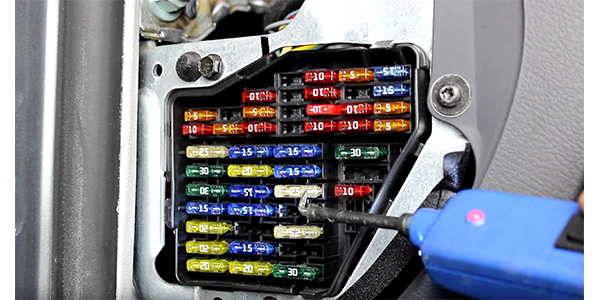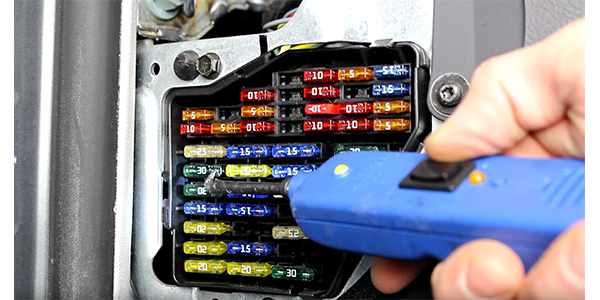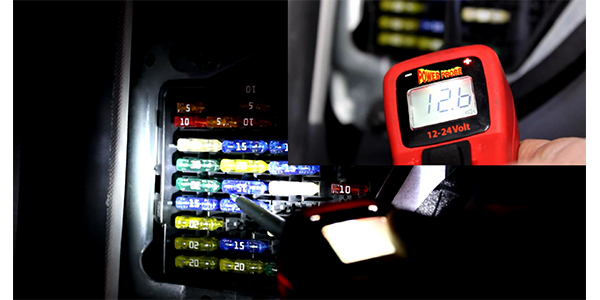
This month I’m going to do a review and demo of a powered test light. I’m actually using two different models in my demonstration (Figure 1). This blue one is mine and one of the boys in the shop was nice enough to let me borrow his newer one to talk about too.
The blue one is actually one of my favorite diagnostic tools, sort of bridges the gap between just a generic test light and a digital voltmeter, and the red one has a cool voltage reading on the display.
I’ve been rocking this blue one for probably about eight and a half to nine years and it’s awesome. While there are even newer generations available, at this point there’s no reason for me to replace it. Knock-on-wood, it will not fail anytime soon.
So what can a powered test light do? Not only do they work as a test light so you can check fuses, power and ground, but you can also apply power and ground.

Toggle the switch one way and you apply power, toggle it the other way and you apply ground. It also has lights in the front to light the space that you’re working in (Figure 2). I think the newer ones are probably a bit brighter than mine, but again, mine is rocking and rolling, so no reason to replace it.

It also has an extra wire for a static ground (Figure 3), which allows you to apply both power and ground — basically turn components on.


Out in the Passat, I’m just running down checking fuses. If you watch the video, you’ll notice there’s a tone difference between power and ground and there’s a little light that lights up red for power and green for ground (Figures 4 and 5).

As we move to the newer light, you’ll notice there’s a volt reading on the display (Figure 6) and I think that’s one of the big advantages of the newer model.
In the real world, how do I use this? Well, I don’t really use a test light. If I have to check fuses, I break out my powered test light, hook it on the battery and just buzz down the fuses. To me, seeing it is great, but my brain seems to process whether a fuse is good or bad faster by listening to the tone.

I’ve modified mine a little bit with a bent tip to get into the fuse panel a little easier (Figure 7) and this other one is straight. I actually have another tip for mine as well.
When I bought the tester it came in a big kit. Not only did it come with the test light, but it also came with a short lead and a longer lead as well as a 12-volt outlet plug so you can hook it up in the cigarette lighter to apply power and ground for the device. It also has an extended cable, which is ultra cool.

Aside from checking fuses, what else can you do with one of these? We can turn stuff on. I have a light bulb here and I’m going to apply the static ground on the lead from the test light. I hear it read ground, so I know I have a ground and I’m going to apply power to light the bulb (Figure 8). With this product, you can do that with just about anything.
As an added feature, there is also a 15-amp circuit breaker built in to protect the circuitry.
If I’m concerned to the point where I need to know exact voltage, I’m going to break out my multimeter and read the voltage that way, but I like having the digital read out on this newer model because it is really helpful for bouncing down and doing quick tests. Also, if you’re dealing in something that might be a five-volt circuit, on mine, the tone is weak when the voltage is low, but the one with the display will give you a better idea and it’s very accurate.
With a powered test light, you do need to be careful. Don’t be the person who’s jamming the probe tip into wires and tearing up wire ends. I really hate seeing that. You also need to know what circuit you’re working on. You don’t want to be just going through powering up different spots on an ECM or another control module; that’s a good way to burn up a board and an ECM.
Again, these are super easy to connect and use; just pop the leads on the battery and you’re good to go. This is one of my favorite diagnostic tools that I’ve ever owned. I highly recommend it.
I like the way it works and it makes things fast for me. The tone works really well, especially when checking fuses. You can also power relays and motors and it will power secondary air pumps on Volkswagens just for a few seconds, but just enough to turn the motor on and make sure it actually comes on. I think this is a great tool and I think the price point is good too.
Every good technician should have one. No, it doesn’t have the features of a full multimeter, but I’ll tell you for a quick read on stuff, this is fantastic.
Editor’s Note: If you want to watch this video, go to
youtube.com/watch?v=2dz_CevXB1k. If you have any questions or concerns, post them below the video or send Charles an email at [email protected].













